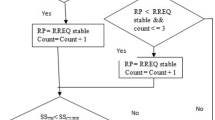Abstract
A mobile ad hoc network (MANET) is a self-configuring network of mobile devices connected with wireless link. The topology of an ad hoc network changes due to the movement of mobile hosts. In MANETs, the data packet may fail to be delivered or a route is to be established again for various reasons including packet collision, nodes movement and bad channel conditions. The proposed research work intelligent route formation technique in ad hoc networks using node mobility behaviour (IRF-NMB) modifies ad hoc on demand distance vector (AODV) to improve its performance by selecting nodes in a route to destination on the basis of past mobile behavior of nodes. The mobility behavior of nodes in proposed method is modeled using random waypoint model. The performed simulation compares packet delivery ratio versus number of nodes, packet delivery ratio versus node max speed (m/s), end to end delay versus number of nodes, end to end delay node max speed (m/s) of stability routing base on reverse AODV (Hua and Li in International conference on ICCSNT, 2011) and IRF-NMB. Simulation result shows that our scheme improves the routing protocols.









Similar content being viewed by others
References
Perkins RFC [3561] (2003) On demand distance vector (AODV) routing: experimental protocol for the internet community July 2003
Kaur R, Rai MK (2012) A novel review on routing protocols in MANETs. Undergrad Acad Res J (UARJ) ISSN 1(1):2278–1129
Camp T, Boleng J, Davies V (2002) Survey of mobility models: wireless communication and mobile computing (WCMC): special issue on mobile AdHoc networking, research. Trends Appl 2(5):483–502
Royer EM, Perkins CE (1999) Multicast operation of the ad-hoc on-demand distance vector routing protocol. In: MobiCom ′99 Proceedings of the 5th annual ACM/IEEE international conference on Mobile computing and networking, ACM, New York, pp 207–218 ©1999 table of contents, ISBN:1-58113-142-9
Hua Y, Li Z (2011) A stability routing protocols base on reverse AODV. In: 2011 international conference on computer science and network technology (ICCSNT), Vol 4. IEEE
Gerla M, Chen L.-J, Lee Y.-Z, Zhou B, Chen J, Yang G, Das S (2005) Dealing with node mobility in ad hoc wireless network Computer Science Department, UCLA, Los Angeles, CA 90095, USA
Kourkouzelis D (1997) Multipath routing using diffusing computations
Broch J, Maltz DA, Johnson DB, Hu Y.-C, Jetcheva J (1998) A performance comparison of multi-hop wireless ad hoc network routing protocols. In: Proceedings of the 4th international conference on mobile computing and networking (ACM MOBI-COM\’98), pp 85–97, 1998
Oliveira R et al (2010) The impact of node’s mobility on link-detection based on routing hello messages. In: Wireless communications and networking conference (WCNC), 2010, IEEE
Author information
Authors and Affiliations
Corresponding author
Rights and permissions
About this article
Cite this article
Pandey, S., Pal, P. & Mukherjee, A. IRF-NMB: Intelligent Route Formation Technique in Ad Hoc Network Using Node Mobility Behaviour. Natl. Acad. Sci. Lett. 38, 213–219 (2015). https://doi.org/10.1007/s40009-015-0388-y
Received:
Revised:
Accepted:
Published:
Issue Date:
DOI: https://doi.org/10.1007/s40009-015-0388-y




